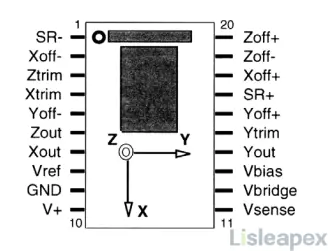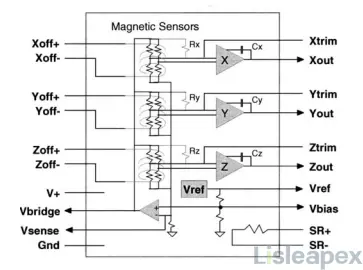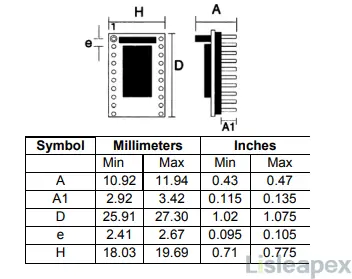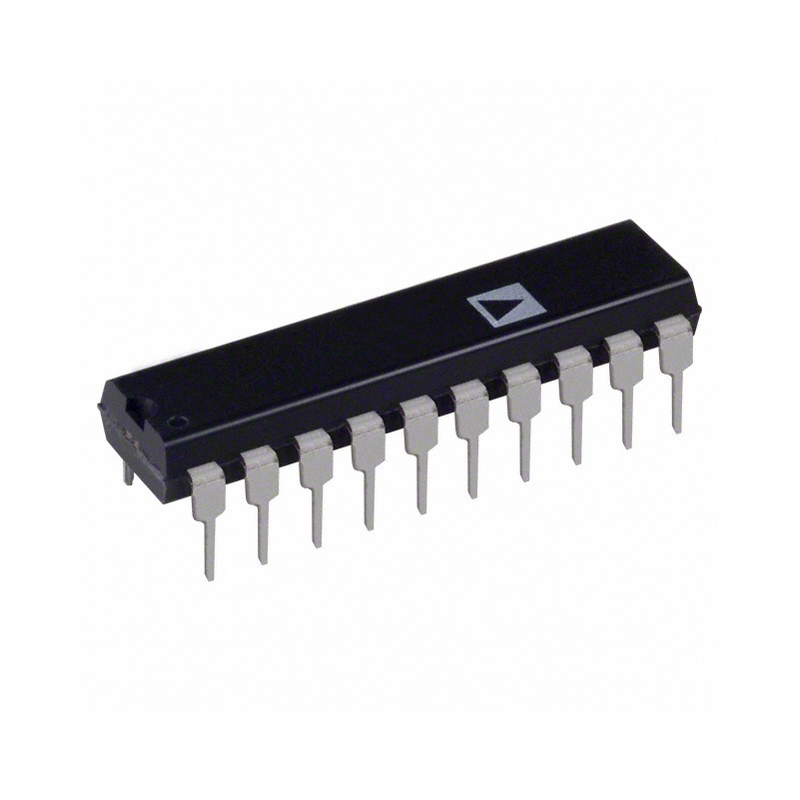HMC2003 Overview
The Honeywell HMC2003 is a high-sensitivity three-axis magnetic sensor used to measure low magnetic field strengths. It incorporates Honeywell's reliable magneto-resistive sensors and analog interface for flexibility. The device features precision amplifiers and filters for accurate measurements while rejecting noise.

With sensitivity to detect fields as low as 40 microgauss and up to ±2 gauss, it provides analog outputs for each axis. The compact design with integrated offset straps eliminates the need for external coils. Additionally, set/reset pins minimize signal degradation from temporary high magnetic fields. Overall, the HMC2003 offers precise, reliable magnetic sensing for various applications, including compass navigation and anomaly detection.
HMC2003 Pinout

Pin Configuration
Here's the pin description for the HMC2003 sensor:
- SR-: Sensor reset negative input for resetting the internal state of the sensor.
- Xoff-: Negative input for X-axis offset calibration, used to calibrate the X-axis offset of the sensor.
- Ztrim: Input for Z-axis adjustment, used to adjust the sensitivity of the sensor along the Z-axis.
- Xtrim: Input for X-axis adjustment, used to adjust the sensitivity of the sensor along the X-axis.
- Yoff-: Negative input for Y-axis offset calibration, used to calibrate the Y-axis offset of the sensor.
- Zout: Z-axis output, provides the analog output signal representing the measured magnetic field intensity along the Z-axis.
- Xout: X-axis output, provides the analog output signal representing the measured magnetic field intensity along the X-axis.
- Vref: Reference voltage input, provides the reference voltage for sensor operation.
- GND: Ground pin, connected to the system ground.
- V+: Positive power supply pin, connected to the positive power supply of the system.
- Vsense: Sensor voltage sensing pin, used to measure the output voltage of the sensor.
- Vbridge: Bridge voltage pin, used to measure the bridge voltage of the sensor.
- Vbias: Bias voltage pin, provides the bias voltage for the internal circuitry of the sensor.
- Vout: Analog output pin, provides the analog output signal representing the measured magnetic field intensity.
- Ytrim: Input for Y-axis adjustment, used to adjust the sensitivity of the sensor along the Y-axis.
- Yoff+: Positive input for Y-axis offset calibration, used to calibrate the Y-axis offset of the sensor.
- SR+: Sensor reset positive input for resetting the internal state of the sensor.
- Xoff+: Positive input for X-axis offset calibration, used to calibrate the X-axis offset of the sensor.
- Zoff-: Negative input for Z-axis offset calibration, used to calibrate the Z-axis offset of the sensor.
- Zoff+: Positive input for Z-axis offset calibration, used to calibrate the Z-axis offset of the sensor.
HMC2003 Specifications
|
Parameter |
Value |
|
IC Classification |
Integrated Circuit (IC) |
|
Number of Bridge per Chip |
3 |
|
Number of Axis |
3 |
|
Maximum Magnetic Field |
2 Gauss (Gs) |
|
Maximum Sensitivity |
1.02 Volts per Gauss (V/Gs) |
|
Maximum Operating Supply Voltage |
15 Volts |
|
Typical Operating Supply Voltage |
9 Volts (Min), 12 Volts (Max) |
|
Minimum Operating Temperature |
-40°C |
|
Maximum Operating Temperature |
85°C |
|
Packaging |
Box |
|
Mounting |
Through Hole |
|
Package Height |
8.52 mm (Max) |
|
Package Width |
19.69 mm (Max) |
|
Package Length |
27.3 mm (Max) |
|
PCB changed |
20 |
|
Standard Package Name |
Dual In-line Package (DIP) |
|
Supplier Package |
DIP Module |
|
Pin Count |
20 |
Features of HMC2003
- Package Type: 20-pin Wide DIP footprint (1” by 0.75”).
- Precision 3-axis Capability: Accurate sensing across X, Y, and Z axes.
- Factory Calibrated Analog Outputs: Ensures consistent performance.
- Dynamic Range: 40 micro-gauss to ±2 gauss.
- Analog Output Sensitivity: 1 Volt/gauss (2.5V @ 0 gauss).
- Onboard +2.5 Volt Reference: Simplifies sensor operation.
- Single Supply Operation: +6 to +15 Volt DC.
- Low Magnetic Material Content: Minimizes interference.
- Operating Temperature Range: -40°C to 85°C.
HMC2003 Application & Uses
Compassing: The HMC2003 sensor is widely utilized in compassing applications, providing accurate measurement of magnetic fields to determine direction and orientation. It is commonly employed in compass modules for navigation systems in various industries, including automotive, marine, and aerospace.
Navigation Systems: Leveraging its precision 3-axis capability and factory-calibrated analog outputs, the HMC2003 sensor plays a crucial role in navigation systems. It provides reliable data for determining position, heading, and attitude reference in applications such as GPS receivers, inertial navigation systems, and unmanned aerial vehicles (UAVs).
Attitude Reference: With its dynamic range and sensitivity, the HMC2003 sensor serves as a key component in attitude reference systems. It accurately measures the Earth's magnetic field to determine the orientation of vehicles, aircraft, and spacecraft, ensuring stable and reliable performance in dynamic environments.
Traffic Detection: The HMC2003 sensor's ability to detect magnetic fields makes it suitable for traffic detection applications. It can be used in traffic monitoring systems to detect the presence and movement of vehicles on roadways, enabling efficient traffic flow management and congestion avoidance.
Proximity Detection: In addition to its compassing and navigation capabilities, the HMC2003 sensor is also utilized in proximity detection systems. It can detect changes in magnetic fields caused by nearby objects, making it suitable for applications such as proximity sensors in industrial automation, robotics, and security systems.
Medical Devices: The HMC2003 sensor finds applications in medical devices where precise measurement of magnetic fields is required. It can be integrated into devices such as MRI machines, patient monitoring systems, and medical imaging equipment to accurately detect and measure magnetic fields, contributing to improved diagnostic and treatment capabilities in healthcare settings.
Overall, the HMC2003 sensor's versatility, accuracy, and reliability make it well-suited for a wide range of applications across various industries, including compassing, navigation systems, attitude reference, traffic detection, proximity detection, and medical devices.
Block Diagram

Package Drawing of HMC2003

Manufacturer
Honeywell's history dates back to 1906 when it was founded in Minneapolis, United States. Initially focusing on heating systems, the company quickly diversified into a wide range of technology and manufacturing ventures. Over time, Honeywell expanded its business scope, encompassing aerospace, building technologies, materials science, and safety and productivity solutions.
In the aerospace sector, Honeywell provides a plethora of products and services including aircraft engines, avionics, flight management systems, propulsion systems, and navigation technologies. These are widely utilized in commercial aviation, military aviation, and space exploration.
Within the realm of building technologies, Honeywell offers building automation systems, security solutions, fire detection systems, and energy efficiency solutions for commercial, industrial, and residential buildings, enhancing comfort, safety, and energy utilization efficiency.
In the realm of materials and technological performance, Honeywell offers various specialty chemicals, process technologies for refining and petrochemical industries, and advanced materials used in diverse applications spanning automotive, aerospace, electronics, healthcare, and beyond.
In the safety and productivity solutions domain, Honeywell delivers industrial safety equipment, personal protective gear, scanning and mobility devices, as well as warehouse automation technologies, enhancing workplace safety and productivity.
Honeywell is renowned for its innovative technologies and high-quality products, boasting a global business network and extensive market penetration. The company is headquartered in Charlotte, North Carolina, United States, solidifying its position as one of the world's leading technology and manufacturing enterprises.
Datasheet PDF
Download HMC2003 datasheet PDF here>>
FAQ
-
Can the HMC2003 be used in harsh environments?
It is suitable for use in various environments, including industrial and automotive applications. However, precautions may need to be taken to protect it from moisture, dust, and other contaminants.
-
Is the HMC2003 sensitive to temperature variations?
While the HMC2003 is designed to operate over a wide temperature range, temperature variations can affect its performance. Calibration and compensation techniques may be employed to minimize temperature-related errors.
-
Can the HMC2003 measure both static and dynamic magnetic fields?
Yes, it is capable of measuring both static and dynamic magnetic fields, allowing it to detect changes in magnetic field strength over time.
-
How does a three-axis magnetic sensor work?
These sensors typically utilize Hall effect or magneto-resistive principles to detect changes in magnetic fields. By measuring the strength and direction of the magnetic field along each axis, they can determine the orientation or movement of magnetic objects or detect changes in the Earth's magnetic field.
-
What is a three-axis magnetic sensor used for?
A three-axis magnetic sensor is used to measure magnetic fields in three dimensions: X, Y, and Z axes. It's commonly employed in applications like compasses, navigation systems, and electronic devices to detect changes in magnetic fields.
Stay updated with Lisleapex by signing up for the newsletter


 Congratulations On Your Successful Submission
Congratulations On Your Successful Submission
 Submission Failure
Submission Failure
